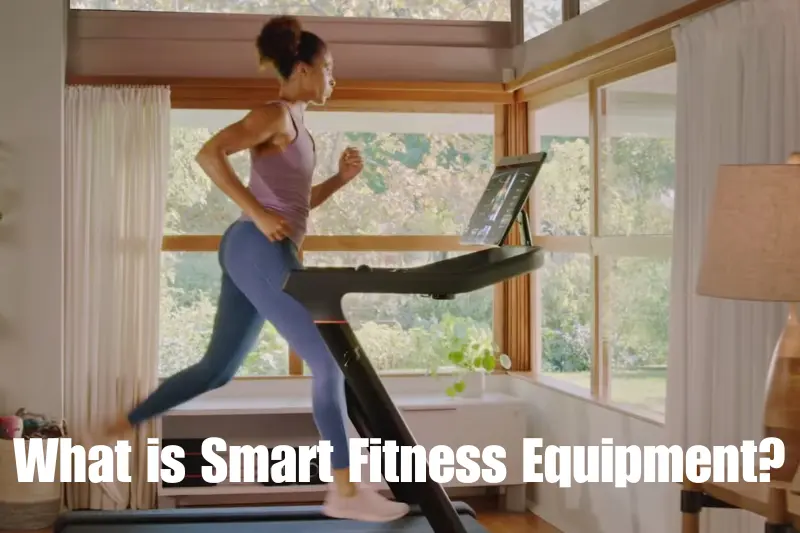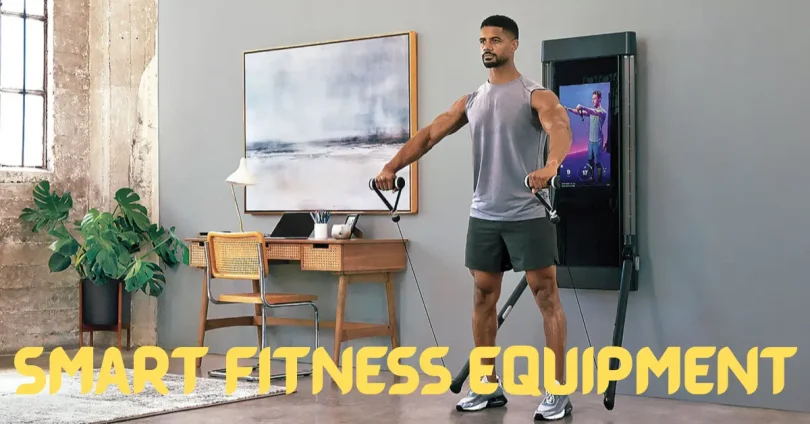In a world where technology is transforming every facet of our daily lives, health and fitness have not been left behind. From wearable trackers that monitor your heart rate to AI-powered machines that offer real-time coaching, the fitness industry has embraced digital innovation with open arms. At the forefront of this transformation is a growing category of gear known as smart fitness equipment—devices that blend technology, convenience, and personalization to revolutionize how we exercise.
Whether you’re a beginner seeking structure, a fitness enthusiast looking for motivation, or an athlete aiming to optimize performance, smart fitness equipment adapts to your individual needs. It provides not just a workout—but a fully personalized fitness journey powered by data and interactivity.
What is Smart Fitness Equipment?

Smart fitness equipment refers to workout machines and devices embedded with advanced technology like sensors, Wi-Fi/Bluetooth connectivity, AI algorithms, and mobile integration. These machines go beyond simple reps and resistance—they track your performance, adapt to your goals, and even offer real-time coaching and interactive experiences.
Think of it as your personal trainer, workout planner, and health monitor—all in one device.
You may also like to read this:
Latest Technology Trends In 2025 You Should Know About
The Future Of Technology And Innovation Explained
Top Recovery Technology For Data Protection 2025
Best Wearable Fitness Trackers 2025: Monitor Your Health
Powerful Strength And Performance Tools For Success
Body Optimization Tech For Better Health In 2025
Key Features of Smart Fitness Equipment
As technology redefines modern fitness routines, smart fitness equipment has emerged as a game changer for those seeking personalized, efficient, and immersive workout experiences. Here’s an in-depth look at the core features that set smart fitness gear apart from traditional exercise machines.
1. Real-Time Data Monitoring
One of the most transformative features of smart fitness equipment is its ability to track real-time workout metrics using advanced sensors and wearable integrations.
Key Metrics Tracked:
- Heart Rate: Monitors your exertion level, helping you stay in optimal zones (fat burn, cardio, or peak).
- Calories Burned: Provides accurate estimates using biometric and movement data.
- Reps and Sets: Strength machines automatically count your reps, sets, and even detect improper form.
- Distance, Pace, and Elevation: Essential for cardio equipment like treadmills, bikes, and ellipticals to evaluate performance.
- Sleep and Recovery Data (Wearables): Devices like Fitbit or WHOOP monitor your sleep quality, HRV (Heart Rate Variability), and readiness scores.
Seamless Syncing:
All these data points can be synced in real-time with popular fitness platforms like:
- Apple Health
- Google Fit
- Fitbit App
- Brand-specific apps (e.g., Peloton, iFit, or Tonal)
This enables users to track progress over time, set measurable goals, and gain valuable insights into their overall health.
2. AI-Powered Personalization
Artificial Intelligence (AI) brings adaptive intelligence into fitness routines by tailoring workouts to your unique body type, progress, and preferences.
How It Works:
- Customized Workouts: AI systems analyze your workout history and biometrics to generate plans suited to your fitness goals—whether that’s weight loss, muscle gain, endurance, or mobility.
- Dynamic Difficulty Adjustments: The machine can automatically increase resistance or modify duration based on your ongoing performance.
- Predictive Feedback: Advanced systems anticipate fatigue or overtraining and may recommend rest days or lighter routines to prevent injury.
Outcome:
This makes every session more efficient, effective, and safe, replacing guesswork with data-driven personalization.
3. App and Device Integration
Smart fitness equipment supports full digital ecosystem integration, allowing users to connect with multiple devices and apps for a streamlined experience.
Integration Capabilities:
- Mobile Apps (iOS and Android): Control workouts, track stats, and view historical data.
- Wearable Devices: Sync with smartwatches like the Apple Watch, Garmin, or Fitbit for enhanced tracking and heart rate monitoring.
- Smart TVs & Tablets: Stream workouts directly to large screens for an immersive, studio-style experience at home.
Benefits:
- Keeps your entire fitness journey in one connected hub.
- Ensures easy access to progress metrics, live sessions, and community features.
- Enhances multi-device functionality across your home gym.
4. Interactive Displays and Virtual Training
Today’s smart machines are built with vivid touchscreens and high-speed internet connectivity, enabling a more immersive and educational workout environment.
Key Features:
- Built-in HD Touchscreens: Navigate your routines, view stats, or watch instructors directly on the device.
- Live and On-Demand Classes: Join real-time sessions led by certified trainers or access a library of guided workouts on demand.
- Virtual Landscapes: Experience rowing on rivers, hiking through virtual forests, or cycling through the Alps via 3D environments.
- Gamified Workouts: Turn exercises into engaging games, keeping motivation levels high.
Result:
This creates a dynamic and enjoyable training experience, making users more likely to stay consistent.
5. Voice and Gesture Control
Some smart equipment is equipped with hands-free functionality to ensure seamless and safe interaction during workouts.
Features Include:
- Voice Commands: Use virtual assistants like Amazon Alexa or Google Assistant to start, pause, or adjust settings.
- Gesture Recognition: Some systems detect hand or body movements to control resistance or speed—ideal for HIIT or circuit training.
Benefits:
Hands-free control minimizes workout interruptions and enhances the convenience and flow of your sessions.
Popular Types of Smart Fitness Equipment

1. Smart Treadmills
Smart treadmills enhance traditional running experiences by integrating tech-driven features for cardio lovers.
Features:
- Adjustable speed and incline
- Built-in screens with scenic routes
- Heart rate sensors
- App connectivity
Examples:
- Peloton Tread
- NordicTrack Commercial 2450
Benefits:
- Participate in live trainer-led runs
- Track performance zones and stride patterns
- Enjoy immersive outdoor-like runs from indoors
2. Smart Exercise Bikes
Ideal for high-intensity cardio or group workouts, smart bikes bring studio cycling to your home.
Features:
- Digital resistance control
- On-screen leaderboards
- Custom workout libraries
Examples:
- Peloton Bike+
- Echelon Smart Connect
- MYX Fitness Bike
Benefits:
- Social engagement through virtual races or challenges
- Track performance and compete with peers in real time
- Get coached through motivational spin classes
3. Smart Rowing Machines
These provide full-body workouts with an emphasis on low-impact cardio and muscle engagement.
Features:
- Magnetic or water resistance
- Interactive video coaching
- Rowing analytics (stroke rate, power output, etc.)
Examples:
- Hydrow
- Ergatta
- CITYROW GO
Benefits:
- Total-body engagement
- Scenic waterways and coach feedback
- Ideal for joint-friendly cardio
4. Smart Strength Training Equipment
Strength machines have gone digital—no more metal plates or guesswork.
Features:
- Digital resistance that adjusts automatically
- Motion tracking for proper form
- Virtual trainers and progress dashboards
Examples:
- Tonal
- Tempo
- Vitruvian Trainer+
- NordicTrack Vault
Benefits:
- Targeted strength routines for any level
- Feedback on posture and form
- Real-time spotting and rep counting
5. Wearables and Smart Home Gyms
Wearable Features:
- HRV tracking
- Sleep quality and stress monitoring
- Readiness and recovery scores
Home Gym Examples:
- WHOOP
- Oura Ring
- Fitbit Sense
- Apple Watch
Smart Gym Setups:
- Mirror (Lululemon Studio)
- Forme Studio
Benefits:
- Total health tracking beyond workouts
- Access to guided workouts, yoga, strength, meditation
- Space-saving and elegant solutions for small homes
Benefits of Using Smart Fitness Equipment
✅ Personalized Workouts
Smart equipment uses your data to create fitness programs tailored to your goals, experience level, and physical condition.
✅ Motivation and Accountability
Receive achievement badges, streak tracking, and real-time encouragement from coaches or community members to stay on track.
✅ Real-Time Feedback
AI-powered systems correct your form, count your reps, and let you know when to push or recover—helping reduce injury risks and maximize gains.
✅ Convenience and Accessibility
Train from the comfort of your home with studio-quality workouts, flexible timing, and minimal setup.
✅ Long-Term Progress Tracking
Access visual performance graphs, weekly summaries, and health reports to track improvements, adjust goals, and celebrate milestones.
Top Brands in Smart Fitness Equipment
Here are some industry leaders pushing boundaries:
| Brand | Notable Product | Key Features |
| Peloton | Peloton Bike/Tread | Live classes, leaderboard |
| Tonal | Tonal Smart Gym | Digital weights, virtual trainer |
| Mirror | Lululemon Studio Mirror | Wall-mounted smart gym |
| NordicTrack | Commercial Treadmills | iFit integration, terrain videos |
| Hydrow | Smart Rower | Scenic rowing, AI feedback |
Challenges and Considerations
While smart fitness equipment offers significant advantages, there are some things to consider:
- Cost: Many smart machines are expensive ($1,000–$4,000+).
- Subscriptions: Some features require monthly fees (e.g., Peloton, iFit).
- Connectivity: Devices need a stable internet connection for streaming.
- Space: Some machines are bulky and require dedicated workout areas.
The Future of Smart Fitness Equipment
As technology advances, the future of smart fitness is incredibly promising. Here’s what to expect:
- More compact and modular equipment
- Increased use of virtual reality (VR) and augmented reality (AR)
- Biometric sensors for real-time blood oxygen and hydration levels
- AI-driven nutrition planning and recovery coaching
- Fully integrated home fitness ecosystems powered by IoT
Conclusion
Smart fitness equipment is reshaping how we work out—offering data-driven personalization, real-time feedback, and immersive training experiences right at home. Whether you’re a beginner or a seasoned athlete, these tools adapt to your goals, track your progress, and keep you motivated.
While the upfront cost and space requirements are worth considering, the long-term benefits—from improved health tracking to studio-quality workouts—make it a game-changer. As technology evolves, expect even smarter features like VR workouts, advanced biometric sensors, and fully integrated home fitness ecosystems.
FAQs
1. What is smart fitness equipment?
Smart fitness equipment includes workout machines and wearables that use technology like sensors, Bluetooth/Wi-Fi, and AI to monitor performance, deliver personalized workouts, and sync with fitness apps for data tracking.
2. How does smart fitness equipment personalize workouts?
Using AI and machine learning, these devices analyze your fitness level, progress, and goals to adjust resistance, suggest exercises, and recommend rest or intensity changes in real time.
3. Do I need a subscription to use smart fitness gear?
Many smart machines (like Peloton or Tonal) offer basic features without a subscription, but full access to live classes, personalized programs, and virtual coaching often requires a monthly membership.
4. Can I use smart fitness equipment without internet?
Basic functions may work offline, but features like streaming classes, syncing data, or software updates usually require a stable internet connection.
5. What apps are compatible with smart fitness devices?
Popular platforms include Apple Health, Google Fit, Fitbit, Strava, and brand-specific apps like iFit, Peloton, or Tonal. Most smart devices offer multi-app integration.



